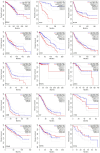Role of LMO7 in cancer (Review)
- PMID: 38994754
- PMCID: PMC11267500
- DOI: 10.3892/or.2024.8776
Role of LMO7 in cancer (Review)
Abstract
Cancer constitutes a multifaceted ailment characterized by the dysregulation of numerous genes and pathways. Among these, LIM domain only 7 (LMO7) has emerged as a significant player in various cancer types, garnering substantial attention for its involvement in tumorigenesis and cancer progression. This review endeavors to furnish a comprehensive discourse on the functional intricacies and mechanisms of LMO7 in cancer, with a particular emphasis on its potential as both a therapeutic target and prognostic indicator. It delves into the molecular attributes of LMO7, its implications in cancer etiology and the underlying mechanisms propelling its oncogenic properties. Furthermore, it underscores the extant challenges and forthcoming prospects in targeting LMO7 for combating cancer.
Keywords: LIM domain only 7; cancer; tumorigenesis.
Conflict of interest statement
The authors declare that they have no competing interests.
Figures





Similar articles
-
LMO7 exerts an effect on mitosis progression and the spindle assembly checkpoint.Int J Biochem Cell Biol. 2018 Jan;94:22-30. doi: 10.1016/j.biocel.2017.11.006. Epub 2017 Nov 20. Int J Biochem Cell Biol. 2018. PMID: 29158164
-
Circulating exosomal microRNA-96 promotes cell proliferation, migration and drug resistance by targeting LMO7.J Cell Mol Med. 2017 Jun;21(6):1228-1236. doi: 10.1111/jcmm.13056. Epub 2016 Dec 27. J Cell Mol Med. 2017. PMID: 28026121 Free PMC article.
-
LMO7 Is a Negative Feedback Regulator of Transforming Growth Factor β Signaling and Fibrosis.Circulation. 2019 Jan 29;139(5):679-693. doi: 10.1161/CIRCULATIONAHA.118.034615. Circulation. 2019. PMID: 30586711 Free PMC article.
-
LIM-domain-only proteins in cancer.Nat Rev Cancer. 2013 Feb;13(2):111-22. doi: 10.1038/nrc3418. Epub 2013 Jan 10. Nat Rev Cancer. 2013. PMID: 23303138 Review.
-
Paving the path for invasion: The polyedric role of LASP1 in cancer.Tumour Biol. 2017 Jun;39(6):1010428317705757. doi: 10.1177/1010428317705757. Tumour Biol. 2017. PMID: 28621232 Review.
Cited by
-
Non-coding RNAs as key regulators in hepatitis B virus-related hepatocellular carcinoma.Front Immunol. 2025 Jun 23;16:1602252. doi: 10.3389/fimmu.2025.1602252. eCollection 2025. Front Immunol. 2025. PMID: 40625740 Free PMC article. Review.
-
Exosomal ncRNAs in liquid biopsy: a new paradigm for early cancer diagnosis and monitoring.Front Oncol. 2025 Jul 9;15:1615433. doi: 10.3389/fonc.2025.1615433. eCollection 2025. Front Oncol. 2025. PMID: 40703556 Free PMC article. Review.
-
Comprehensive exploration of signal sequence receptor subunit 1 (SSR1) as a diagnostic and prognostic biomarker in liver hepatocellular carcinoma.Am J Transl Res. 2025 Jan 15;17(1):560-584. doi: 10.62347/ANXV3598. eCollection 2025. Am J Transl Res. 2025. PMID: 39959210 Free PMC article.
-
Current Landscape and Future Directions in Cancer Immunotherapy: Therapies, Trials, and Challenges.Cancers (Basel). 2025 Feb 27;17(5):821. doi: 10.3390/cancers17050821. Cancers (Basel). 2025. PMID: 40075668 Free PMC article. Review.
-
[Villin-like protein VILL suppresses proliferation of nasopharyngeal carcinoma cells by interacting with LMO7 protein].Nan Fang Yi Ke Da Xue Xue Bao. 2025 May 20;45(5):954-961. doi: 10.12122/j.issn.1673-4254.2025.05.07. Nan Fang Yi Ke Da Xue Xue Bao. 2025. PMID: 40415426 Free PMC article. Chinese.
References
-
- Wang X, Chen G, Zhang Y, Ghareeb WM, Yu Q, Zhu H, Lu X, Huang Y, Huang S, Hou D, Chi P. The impact of circumferential tumour location on the clinical outcome of rectal cancer patients managed with neoadjuvant chemoradiotherapy followed by total mesorectal excision. Eur J Surg Oncol. 2020;46:1118–1123. doi: 10.1016/j.ejso.2020.07.024. - DOI - PubMed
Publication types
MeSH terms
Substances
LinkOut - more resources
Full Text Sources
Medical
Molecular Biology Databases

